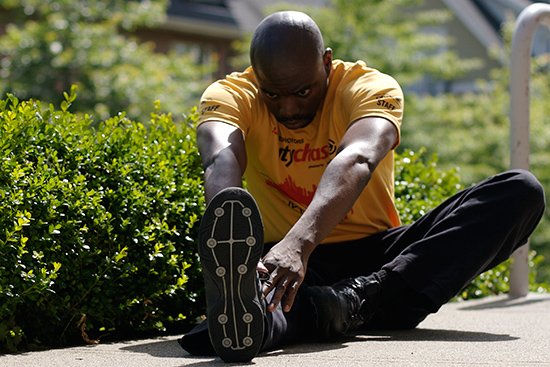Stretch Before Exercise? Not So Fast.
BU experts on how you should warm up

If exercising is part of your New Year’s resolutions, stretching beforehand is a bad idea. Photo by Phillip Jeffrey
Once upon a time, stretching was to exercise what proposing is to marriage: an essential ritual that had to be done before the main event. Athletes of a certain age were warned to stretch their muscles before exerting themselves to avoid a debilitating pull or injury.
Oops.
Recent studies caution people away from stretching before workouts, suggesting it actually impedes your body’s performance. According to this research, runners run more slowly, jumpers jump less high, and weight lifters lift more weakly by stretching, without significantly ensuring against injury during their exercise.
With the new semester well under way and (at least some) people still vowing to exercise as their New Year’s resolution, we asked three BU fitness experts to describe how they warm up before sweating, and what they’d advise others. Here are their answers.
James Camarinos, Ryan Center for Sports Medicine and Rehabilitation physical therapy center clinic manager
I recommend stretching after exercise or even at nonexercise times—for example, stretch in the middle of an eight-hour day sitting at your desk—instead of the typical stretch-before-you-work-out strategy that many employed for years. Stretching a muscle should be done when the muscle is short, meaning the length is not sufficient for the task that a person is trying to do. A person who competes in hurdles needs a long hamstring muscle to clear their leg over the hurdle; however, most typical runners with shorter strides will not need this, so endlessly stretching one’s hamstring to prep for a 10K might not get them far.
Most people stretch to loosen up. However, this would be much better accomplished with a more dynamic warm-up. Things like high knees, front kicks, back kicks (hit your glutes with your feet by bending your knee back), hip circles (roll your leg out and to the front with a bent knee), squats, lunges, or even lightly biking or elliptical will much better lengthen a muscle, but will do so with movement so as to increase the tissue temperature of the muscle and better prepare it for exercise.
Mike Lagomarsine, Fitness and Recreation Center director of fitness
The biggest issue is the confusion between flexibility training and warming up for exercise. Stretching, defined as gently bringing your joint to its end range of motion, is how you increase flexibility. So for someone looking to gain flexibility, I would recommend static stretching, holding the stretch for usually between 30 and 90 seconds. On the other hand, for someone doing a typical gym workout, the warm-up should not be static stretching, but instead a more dynamic, or moving, stretching. This will warm up the body by getting the heart rate elevated and move the body through a range of motion, but will do so actively. That can be anything from cardio machines (treadmill, elliptical, bike) to jumping jacks to jogging to jump rope. Anything that is of moderate intensity and uses major muscle groups.
Glenn Harris, Boston University Athletics head strength and conditioning coach
I suggest that people go through a dynamic stretching routine instead of a static stretching routine prior to exercising. Bringing the body through a range of motion can actually prepare it for the demands of the exercise session. For prepractice or pregame warm-up, we will go through a continuous warm-up, which is a series of running drills. The drills increase in difficulty and demand until the body is warmed up. After the warm-up series is complete, we will then perform some dynamic stretching for different parts of the body, including arm circles, leg swings, spider-man stretch, and inchworm walks.

Comments & Discussion
Boston University moderates comments to facilitate an informed, substantive, civil conversation. Abusive, profane, self-promotional, misleading, incoherent or off-topic comments will be rejected. Moderators are staffed during regular business hours (EST) and can only accept comments written in English. Statistics or facts must include a citation or a link to the citation.